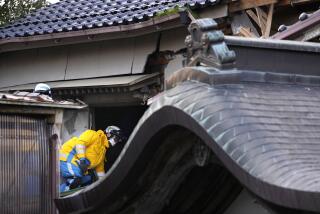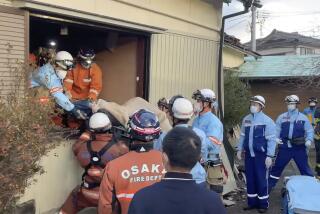DEVASTATING JOLT IN JAPAN : For a Son, Day of Hope, Night of Despair : Rescue: Workers return to damaged building to search for a man’s father, but a grim discovery greets them.
- Share via
KOBE, Japan — By Friday morning, there wasn’t much hope for Sei Bun Kei. But the steel-frame apartment building in which the 62-year-old Korean man had lived was not demolished like so many homes in Kobe. It was the kind of place where someone might be trapped alive.
In the two days after Tuesday’s massive earthquake, rescue workers had pulled 18 residents--some dead, some alive--from the damaged three-story structure. Thursday they moved on to other sites.
But his son, Motoyasu Sei, 35, believed that his father was still inside.
The force of the earthquake had bent, twisted and crushed the lower part of the building, leaving the upper floors leaning on a neighboring house and a narrow space between the two buildings near ground level.
The elder Sei lived on the first floor.
Although hope was slim, Motoyasu Sei and another man who also believed that a relative was inside tried Thursday to break through the rubble by themselves.
“We started digging but felt it was almost impossible,” he said. “So we asked them to search again today.”
Many victims still lie buried in the rubble of collapsed buildings, but there are very few places where people are likely still to be alive, said Mitsuru Nakatani, the fire chief responsible for this rescue operation. But Sei’s building seemed like a good place to try.
Friday afternoon, a dozen firefighters, wielding electric metal cutters with eight-inch jaws, plus ordinary metal shears and saws, began work again. They continued into the night under lights powered by generators.
Kobe firefighters had worked without taking time to eat for the first 24 hours after the quake and have been at rescue sites nearly 20 hours a day since then, Nakatani said.
“I haven’t been home since the earthquake,” he said. “People are working without any sleep.”
Two teams of firefighters worked into the evening, one cutting through the ceiling into Sei’s room and the other into another room where a woman was believed buried.
Any objects that might identify victims were examined by police at the scene: a white visor cap with the name of someone already accounted for, Korean-language books and eventually Sei Bun Kei’s driver’s license.
About 9 p.m., someone suddenly called out that he could see a body. The person was clearly dead.
Minutes later, the younger Sei said his father had probably been found.
“I’ve been waiting near here all day,” he said stoically. Soon his younger brother arrived. They chose to wait in front of the building rather than watch the sad work.
But another hour went by and the body still had not been identified or freed. A firefighter suggested that the older son take a look to determine whether it was his father.
Motoyasu Sei went through the “tunnel” between the two buildings to the work site and soon returned.
“You can’t really see him yet,” he said. “He’s under a table.”
An hour later, more police officers came running up with a stretcher. A body hidden by a blanket was soon removed.
Motoyasu Sei burst into tears.
More to Read
Sign up for Essential California
The most important California stories and recommendations in your inbox every morning.
You may occasionally receive promotional content from the Los Angeles Times.













